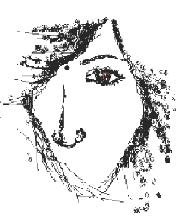 Death of the Historical Buddha (Nehan),
Death of the Historical Buddha (Nehan),Kamakura period (1185–1333),
14th centuryUnidentified artistKyoto,
JapanHanging scroll;
ink, gold, and color on silk;
In paintings of the Buddha's nirvana, his passing from earthly life to the ultimate goal of an enlightened being, essential tenets of Buddhism are explicit: release from the bonds of existence through negation of desires that cause intrinsic suffering. The large, golden body of Shaka (Shakyamuni) faces west in a final trance after a long life of teaching. Those witnessing the Buddha's passing from earthly life reveal their own imperfect level of understanding in the extent of their grief. Bodhisattvas, who have achieved the spiritual enlightenment of Buddhahood, show a solemn serenity not shared by the lesser beings. Except for the Bodhisattva Jizo, who appears as a monk holding a jewel near the center of the bier, these deities are depicted in princely raiment, with jeweled crowns, flowing scarves, and necklaces covering their golden bodies. Disciples with shaved heads who wear patched robes like the Buddha's weep bitterly, as do the multilimbed Hindu deities and guardians who have been converted to his teaching. Men and women of every class, joined by about thirty animals, grieve in their imperfect understanding of the Buddhist ideal. Even the blossoms of the sala trees change hue. From the upper right, Queen Maya, mother of the dying prince, descends, weeping.



No comments:
Post a Comment